The Morphological Evolution of Self-Assembled Silver Nanoparticles under Photoirradiation and Their SERS Performance
Abstract
1. Introduction
2. Materials and Methods
2.1. Synthesis of Spherical Ag Nanoseeds
2.2. Synthesis of Self-Assembled AgNPs with Varying Morphologies
2.3. Characterization Methods
2.4. Design of Sample Holder for SERS Measurement
2.5. SERS Experimental Details
3. Results and Discussion
3.1. Formation of Spherical Ag Nanoseeds
3.2. Morphological Evolution of Photoinduced AgNPs
3.3. The Effect of Morphology on SERS Efficiency
4. Conclusions
Author Contributions
Funding
Data Availability Statement
Acknowledgments
Conflicts of Interest
References
- Zhao, L.; Gu, W.; Zhang, C.; Shi, X.; Xian, Y. In Situ Regulation Nanoarchitecture of Au Nanoparticles/Reduced Graphene Oxide Colloid for Sensitive and Selective SERS Detection of Lead Ions. J. Colloid Interface Sci. 2016, 465, 279–285. [Google Scholar] [CrossRef] [PubMed]
- Paudel, A.; Raijada, D.; Rantanen, J. Raman Spectroscopy in Pharmaceutical Product Design. Adv. Drug Deliv. Rev. 2015, 89, 3–20. [Google Scholar] [CrossRef]
- Bersani, D.; Conti, C.; Matousek, P.; Pozzid, F.; Vandenabeele, P. Methodological Evolutions of Raman Spectroscopy in Art and Archaeology. Anal. Methods 2016, 8, 8395–8409. [Google Scholar] [CrossRef]
- Li, L.; Cao, X.; Zhang, T.; Wu, Q.; Xiang, P.; Shen, C.; Zou, L.; Li, Q. Recent Developments in Surface-Enhanced Raman Spectroscopy and Its Application in Food Analysis: Alcoholic Beverages as an Example. Foods 2022, 11, 2165. [Google Scholar] [CrossRef]
- Kong, K.; Kendall, C.; Stone, N.; Notingher, I. Raman Spectroscopy for Medical Diagnostics—From In-Vitro Biofluid Assays to In-Vivo Cancer Detection. Adv. Drug Deliv. Rev. 2015, 89, 121–134. [Google Scholar] [CrossRef]
- Zannotti, M.; Rossi, A.; Giovannetti, R. SERS Activity of Silver Nanosphere, Triangular Nanoplates, Hexagonal Nanoplates and Quasi-Spherical Nanoparticles: Effect of Shape and Morphology. Coatings 2020, 10, 288. [Google Scholar] [CrossRef]
- Ramirez-Perez, J.C.; Reis, T.A.; Olivera, C.L.P.; Rizzutto, M.A. Impact of Silver Nanoparticles Size on SERS for Detection and Identification of Filamentous Fungi. Spectrochim. Acta A Mol. Biomol. Spectrosc. 2022, 272, 120980. [Google Scholar] [CrossRef] [PubMed]
- Israelsen, N.D.; Hanson, C.; Vargis, E. Nanoparticle Properties and Synthesis Effects on Surface-Enhanced Raman Scattering Enhancement Factor: An Introduction. Sci. World J. 2015, 2015, 124582. [Google Scholar] [CrossRef]
- Pustovit, V.N.; Shahbazyan, T.V. Quantum-Size Effects in SERS from Noble-Metal Nanoparticles. Microelectron. J. 2005, 36, 559–563. [Google Scholar] [CrossRef]
- Petryayeva, E.; Krull, U.J. Localized Surface Plasmon Resonance: Nanostructures, Bioassays and Biosensing—A review. Anal. Chim. Acta 2011, 706, 8–24. [Google Scholar] [CrossRef]
- Rycenga, M.; Camargo, P.H.C.; Li, W.; Moran, C.H.; Xia, Y. Understanding the SERS Effects of Single Silver Nanoparticles and Their Dimers, One at a Time. J. Phys. Chem. Lett. 2010, 1, 696–703. [Google Scholar] [CrossRef]
- Wan, F.; Shi, H.; Chen, W.; Gu, Z.; Du, L.; Wang, P.; Wang, J.; Huang, Y. Charge Transfer Effect on Raman and Surface Enhanced Raman Spectroscopy of Furfural Molecules. Nanomaterials 2017, 7, 210. [Google Scholar] [CrossRef]
- Yamamoto, Y.S.; Ozaki, Y.; Itoh, T. Recent Progress and Frontiers in the Electromagnetic Mechanism of Surface-Enhanced Raman Scattering. J. Photochem. Photobiol. C Photochem. Rev. 2014, 21, 81–104. [Google Scholar] [CrossRef]
- Bandarenka, H.V.; Girel, K.V.; Zavatski, S.A.; Panarin, A.; Terekhov, S.N. Progress in the Development of SERS-Active Substrates Based on Metal-Coated Porous Silicon. Materials 2018, 11, 852. [Google Scholar] [CrossRef]
- Puente, C.; Aguilar, N.P.; Gómez, I.; López, I. Morphology Effect of Photoconverted Silver Nanoparticles on the Performance of Surface-Enhanced Raman Spectroscopy Substrates. ACS Omega 2023, 8, 12630–12635. [Google Scholar] [CrossRef]
- Yue, X.; Zheng, X.; Lv, G.; Mo, J.; Yu, X.; Liu, J.; Jia, Z.; Lv, X.; Tang, J. Synthesis of a Low-Cost, Stable, Silicon-Based SERS Substrate for Rapid, Nondestructive Biosensing. Optik 2019, 192, 162959. [Google Scholar] [CrossRef]
- Zheng, Y.B.; Huang, T.J. Surface Plasmons of Metal Nanostructure Arrays: From Nanoengineering to Active Plasmonics. SLAS Technol. 2008, 13, 215–226. [Google Scholar] [CrossRef]
- Jana, D.; Mandal, A.; De, G. High Raman Enhancing Shape-Tunable Ag Nanoplates in Alumina: A Reliable and Efficient SERS Technique. ACS Appl. Mater. Interfaces 2012, 4, 3330–3334. [Google Scholar] [CrossRef] [PubMed]
- Xue, B.; Wang, D.; Zuo, J.; Kong, X.; Zhang, Y.; Liu, X.; Tu, L.; Chang, Y.; Li, C.; Wu, F.; et al. Towards High Quality Triangular Nanoprisms: Improved Synthesis, Six-Tip Based Hot Spots and Ultra-High Local Surface Plasmon Resonance Sensitivity. Nanoscale 2015, 7, 8048–8057. [Google Scholar] [CrossRef] [PubMed]
- Sovizi, M.; Aliannezhadi, M. Localized Surface Plasmon Resonance (LSPR) of Coupled Metal Nanospheres in Longitudinal, Transverse and Three-Dimensional Coupling Configurations. Optik 2022, 252, 168518. [Google Scholar] [CrossRef]
- Krajczewski, J.; Joubert, V.; Kudelski, A. Light-Induced Transformation of Citrate Stabilized Silver Nanoparticles: Photochemical Method of Increase of SERS Activity of Silver Colloids. Colloids Surf. A Physicochem. Eng. Asp. 2014, 456, 41–48. [Google Scholar] [CrossRef]
- Shiohara, A.; Wang, Y.; Liz-Marzán, L.M. Recent Approaches Toward Creation of Hot Spots for SERS Detection. J. Photochem. Photobiol. C Photochem. Rev. 2014, 21, 2–25. [Google Scholar] [CrossRef]
- Tiwari, V.S.; Oleg, T.; Darbha, G.K.; Hardy, W.; Singh, J.P.; Ray, P.C. Non-Resonance SERS Effects of Silver Colloids with Different Shapes. Chem. Phys. Lett. 2007, 446, 77–82. [Google Scholar] [CrossRef]
- Jin, R.; Cao, Y.W.; Mirkin, C.A.; Kelly, K.L.; Schatz, G.C.; Zheng, J.G. Photoinduced Conversion of Silver Nanospheres to Nanoprisms. Science 2001, 294, 1901–1903. [Google Scholar] [CrossRef] [PubMed]
- Nhung, N.T.H.; Dat, N.T.; Thi, C.M.; Viet, P.V. Fast and Simple Synthesis of Triangular Silver Nanoparticles under the Assistance of Light. Colloids Surf. A Physicochem. Eng. Asp. 2020, 594, 124659. [Google Scholar]
- An, J.; Tang, B.; Ning, X.; Zhou, J.; Zhao, B.; Xu, W.; Corredor, C.; Lombardi, J.R. Photoinduced Shape Evolution: From Triangular to Hexagonal Silver Nanoplates. J. Phys. Chem. C 2007, 111, 18055–18059. [Google Scholar] [CrossRef]
- Nguyen, V.T. Sunlight-Driven Synthesis of Silver Nanoparticles Using Pomelo Peel Extract and Antibacterial Testing. J. Chem. 2020, 2022, 6407081. [Google Scholar] [CrossRef]
- Stamplecoskie, K.G.; Scaiano, J.C.; Tiwari, V.S.; Anis, H. Optimal Size of Silver Nanoparticles for Surface-Enhanced Raman Spectroscopy. J. Phys. Chem. C 2011, 115, 1403–1409. [Google Scholar] [CrossRef]
- Xue, C.; Métraux, G.S.; Millstone, J.E.; Mirkin, C.A. Mechanistic Study of Photomediated Triangular Silver Nanoprism Growth. J. Am. Chem. Soc. 2008, 130, 8337–8344. [Google Scholar] [CrossRef]
- Bartlett, T.R.; Sokolov, S.V.; Plowman, B.J.; Young, N.P.; Compton, R.G. Tracking of Photochemical Ostwald Ripening of NanoParticles Through Voltammetric Atom Counting. Nanoscale 2016, 8, 16075–16530. [Google Scholar] [CrossRef]
- Iravani, S.; Korbekandi, H.; Mirmohammadi, S.V.; Zolfaghari, B. Synthesis of Silver Nanoparticles: Chemical, Physical and Biological Methods. Res. Pharm. Sci. 2014, 9, 385–406. [Google Scholar]
- Chutrakulwong, F.; Thamaphat, K.; Limsuwan, P. Photo-Irradiation Induced Green Synthesis of Highly Stable Silver NanoParticles Using Durian Rind Biomass: Effects of Light Intensity, Exposure Time and pH on Silver Nanoparticles Formation. J. Phys. Commun. 2020, 4, 095015. [Google Scholar] [CrossRef]
- Stamplecoskie, K.G.; Scaiano, J.C. Light Emitting Diode Irradiation Can Control the Morphology and Optical Properties of Silver Nanoparticles. J. Am. Chem. Soc. 2010, 132, 1825–1827. [Google Scholar] [CrossRef]
- Brioude, A.; Pileni, M.P. Silver Nanodisks: Optical Properties Study Using the Discrete Dipole Approximation Method. J. Phys. Chem. B 2005, 109, 23371–23377. [Google Scholar] [CrossRef]
- Saade, J.; Araújo, C.B. Synthesis of Silver Nanoprisms: A Photochemical Approach Using Light Emission Diodes. Mater. Chem. Phys. 2014, 148, 1184–1193. [Google Scholar] [CrossRef]
- Métraux, G.S.; Mirkin, G.A. Rapid Thermal Synthesis of Silver Nanoprisms with Chemically Tailorable Thickness. Adv. Mater. 2005, 17, 412–415. [Google Scholar] [CrossRef]
- Wang, H.; Cui, X.; Guan, W.; Zheng, X.; Zhao, H.; Wang, Z.; Wang, Q.; Xue, T.; Liu, C.; Singh, D.J.; et al. Kinetic Effects in the Photomediated Synthesis of Silver Nanodecahedra and Nanoprisms: Combined Effect of Wavelength and Temperature. Nanoscale 2014, 6, 7295–7302. [Google Scholar] [CrossRef] [PubMed]
- Pisárčik, M.; Lukáč, M.; Jampílek, J.; Bilka, F.; Bilková, A.; Pašková, L.; Devínsky, F.; Horáková, R.; Březina, M.; Opravil, T. Silver Nanoparticles Stabilized with Phosphorus-Containing Heterocyclic Surfactants: Synthesis, Physico-Chemical Properties, and Biological Activity Determination. Nanomaterials 2021, 11, 1883. [Google Scholar] [CrossRef] [PubMed]
- Watanabe, H.; Hayazawa, N.; Inouye, Y.; Kawata, S. DFT Vibrational Calculations of Rhodamine 6G Adsorbed on Silver: Analysis of Tip-Enhanced Raman Spectroscopy. J. Phys. Chem. B 2005, 109, 5012–5020. [Google Scholar] [CrossRef] [PubMed]
- Hildebrandt, P.; Stockburger, M. Surface-Enhanced Resonance Raman Spectroscopy of Rhodamine 6G Adsorbed on Colloidal Silver. J. Phys. Chem. 1984, 88, 5935–5944. [Google Scholar] [CrossRef]
- He, X.N.; Gao, Y.; Mahjouri-Samani, M.; Black, P.N.; Allen, J.; Mitchell, M.; Xiong, W.; Zhou, Y.S.; Jiang, L.; Lu, Y.F. Surface-Enhanced Raman Spectroscopy Using Gold-Coated Horizontally Aligned Carbon Nanotubes. Nanotechnology 2012, 23, 205702. [Google Scholar] [CrossRef] [PubMed]
- Zhong, F.; Wu, Z.; Guo, J.; Jia, D. Porous Silicon Photonic Crystals Coated with Ag Nanoparticles as Efficient Substrates for Detecting Trace Explosives Using SERS. Nanomaterials 2018, 8, 872. [Google Scholar] [CrossRef] [PubMed]
- Wang, R.; Yao, Y.; Shen, M.; Wang, X. Green Synthesis of Au@Ag Nanostructures through a Seed-Mediated Method and Their Application in SERS. Colloids Surf. A Physicochem. Eng. Asp. 2016, 492, 263–272. [Google Scholar] [CrossRef]
- Kelly, K.L.; Coronado, E.; Zhao, L.L.; Schatz, G.C. The Optical Properties of Metal Nanoparticles: The Influence of Size, Shape, and Dielectric Environment. J. Phys. Chem. B 2003, 107, 668–677. [Google Scholar] [CrossRef]



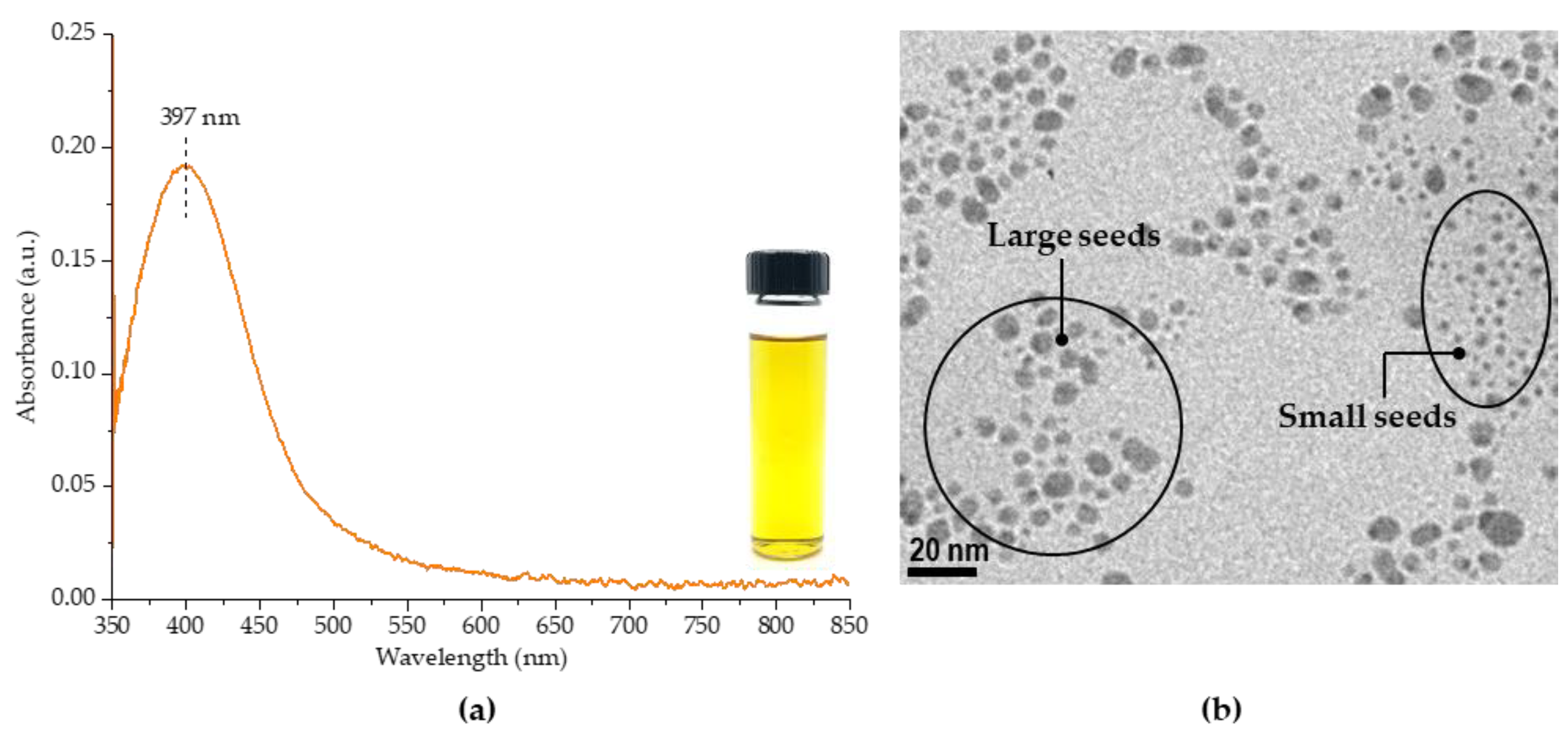
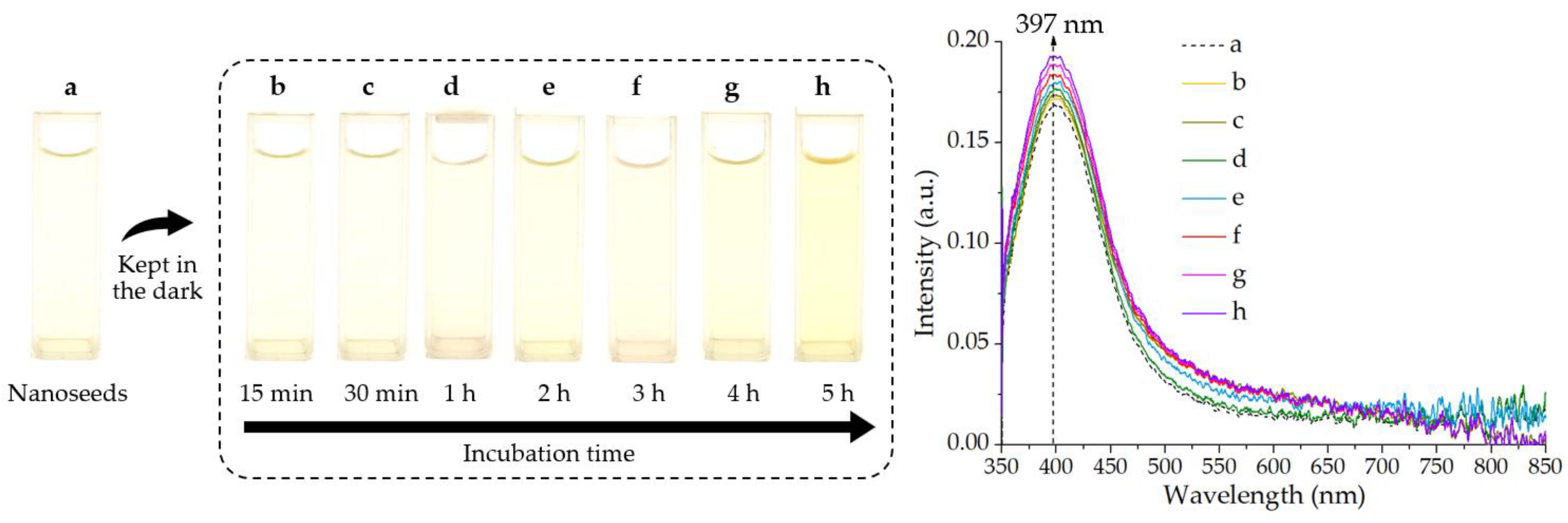
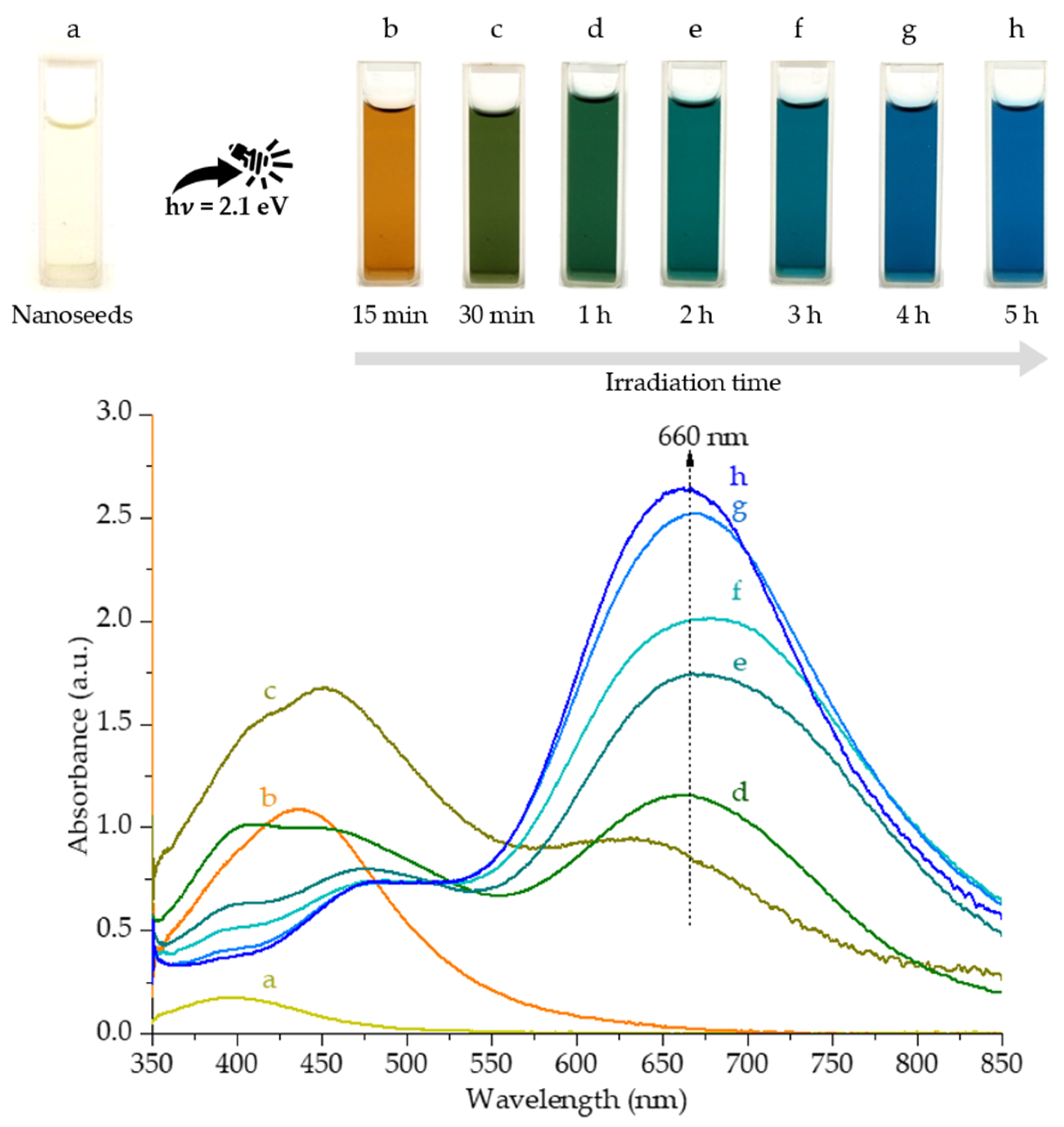

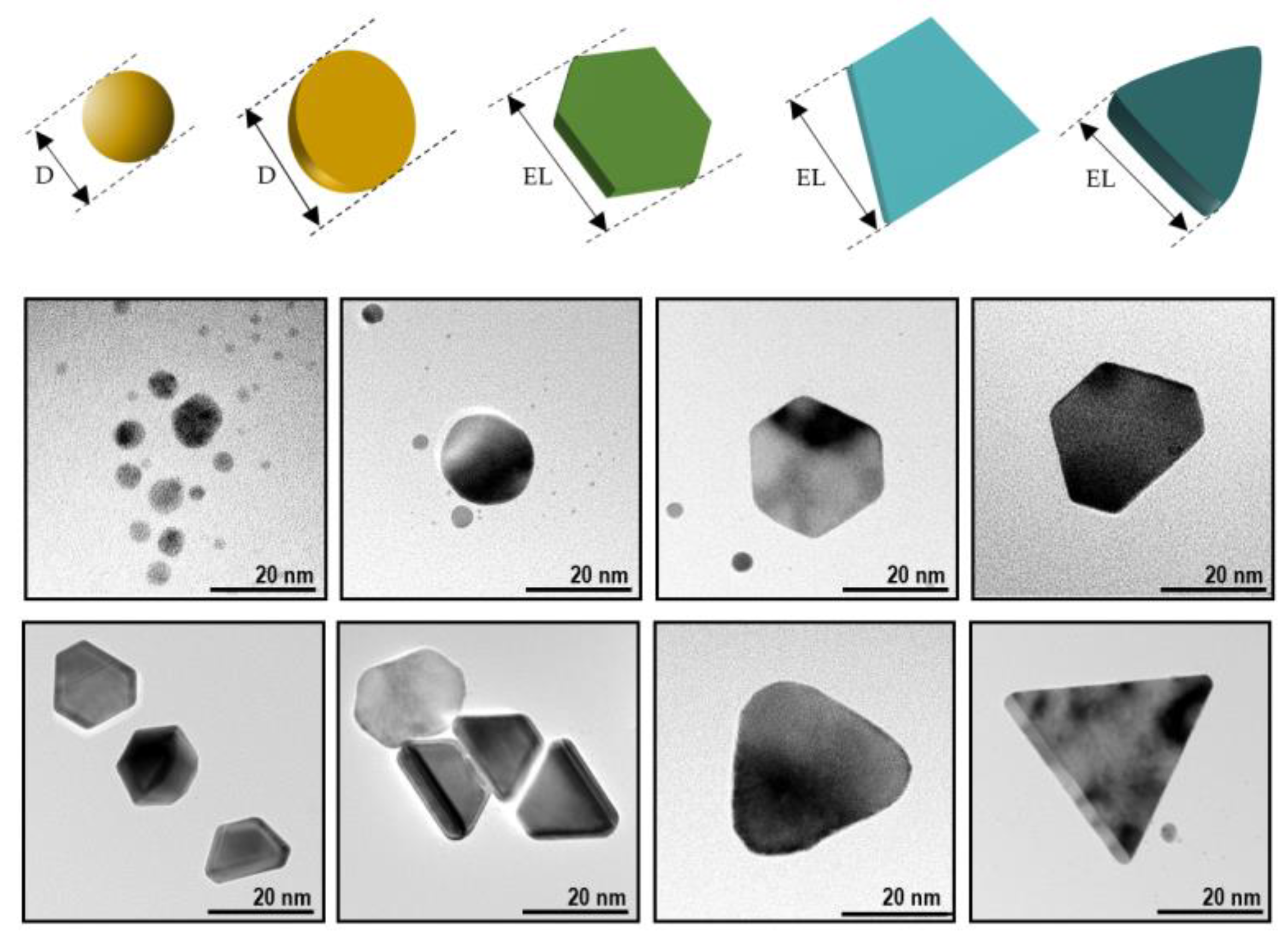

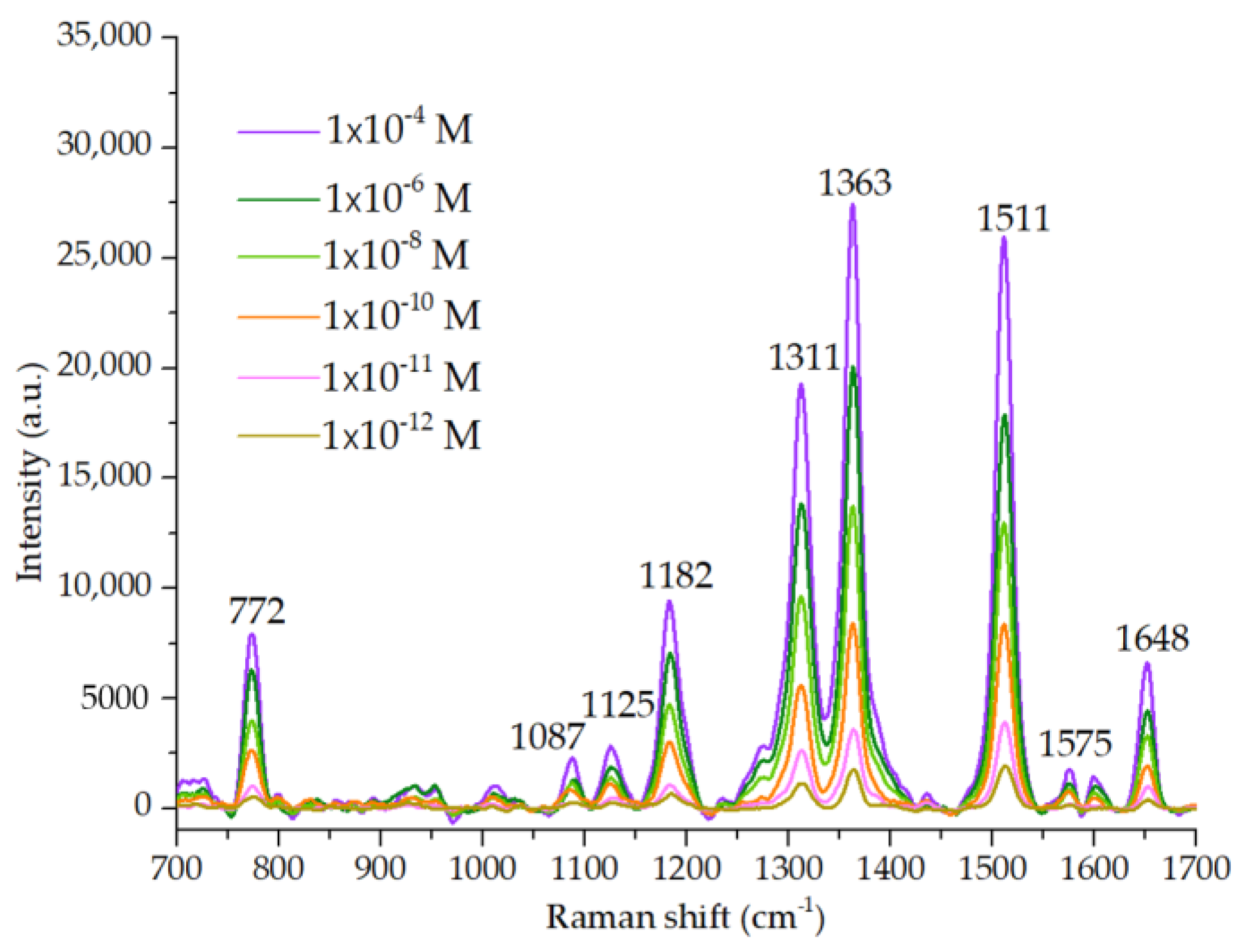
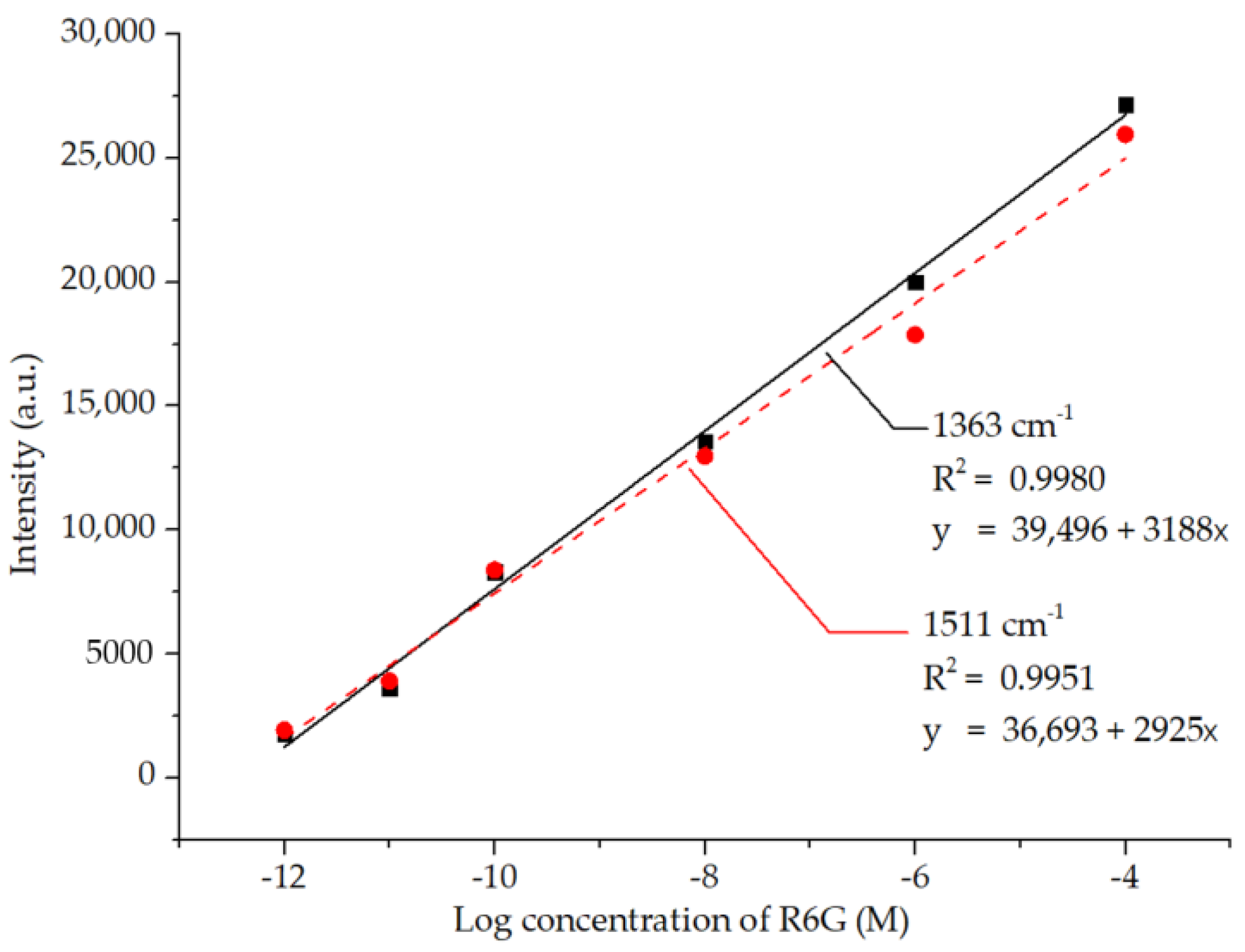
| Irradiation Time | Morphology | |||||
|---|---|---|---|---|---|---|
| Spherical Nanoparticle | Circular Nanoplate | Hexagonal Nanoplate | Trapezoid Nanoplate | Triangular Nanoplate | ||
 |  |  |  |  | ||
| Seed (0 min) | Average size | 3.1 ± 0.1 nm | - | - | - | - |
| Population | 100% | - | - | - | - | |
| 15 min | Average size | 12.5 ± 0.2 nm | - | - | - | - |
| Population | 100% | - | - | - | - | |
| 30 min | Average size | 15.1 ± 0.6 nm | 18.7 ± 1.6 nm | - | - | - |
| Population | 82% | 18% | - | - | - | |
| 1 h | Average size | - | 19.3 ± 1.5 nm | 30.7 ± 1.9 nm | 16.0 ± 1.3 nm | 27.2 ± 2.1 nm |
| Population | - | 46% | 12% | 10% | 32% | |
| 2 h | Average size | - | 24.6 ± 1.1 nm | 36.1 ± 1.6 nm | 35.5 ± 1.0 nm | 30.5 ± 2.6 nm |
| Population | - | 47% | 7% | 11% | 35% | |
| 3 h | Average size | - | 24.7 ± 1.1 nm | 37.9 ± 3.4 nm | - | 34.2 ± 1.1 nm |
| Population | - | 40% | 6% | - | 54% | |
| 4 h | Average size | - | 28.2 ± 1.0 nm | 32.5 ± 4.3 nm | - | 36.2 ± 1.1 nm |
| Population | - | 39% | 3% | - | 58% | |
| 5 h | Average size | - | 29.9 ± 1.0 nm | 44.3 ± 4.5 nm | - | 41.1 ± 1.2 nm |
| Population | - | 34% | 4% | - | 62% | |
| Raman Shift (cm−1) | Band Assignments | References |
|---|---|---|
| 772 (w) | C-H out-of-plane bending | [39,40,41] |
| 1087 (w) | - | [40,41,42] |
| 1125 (w) | C-H in-plane bending in xanthene/phenyl rings | [40,41] |
| 1182 (m) | C-H in-plane bending in xanthene rings | [41] |
| 1311 (w) | Hybrid mode (xanthene/phenyl rings and NHC2H5 group) | [41] |
| 1363 (s) | C−C stretching in xanthene ring | [40,41] |
| 1511 (s) | C−C stretching in xanthene ring | [40,41] |
| 1575 (s) | C−C stretching in phenyl ring | [40,41] |
| 1648 (s) | C=C stretching in xanthene ring | [39,40,41,42] |
| Irradiation Time | AgNPs Morphology | |
|---|---|---|
| 15 min |  | 2 |
| 30 min |  | 601 |
| 1 h |  | 1961 |
| 2 h |  | 1720 |
| 3 h |  | 257 |
| 4 h |  | 205 |
| 5 h |  | 126 |
Disclaimer/Publisher’s Note: The statements, opinions and data contained in all publications are solely those of the individual author(s) and contributor(s) and not of MDPI and/or the editor(s). MDPI and/or the editor(s) disclaim responsibility for any injury to people or property resulting from any ideas, methods, instructions or products referred to in the content. |
© 2023 by the authors. Licensee MDPI, Basel, Switzerland. This article is an open access article distributed under the terms and conditions of the Creative Commons Attribution (CC BY) license (https://creativecommons.org/licenses/by/4.0/).
Share and Cite
Phetsahai, A.; Eiamchai, P.; Thamaphat, K.; Limsuwan, P. The Morphological Evolution of Self-Assembled Silver Nanoparticles under Photoirradiation and Their SERS Performance. Processes 2023, 11, 2207. https://doi.org/10.3390/pr11072207
Phetsahai A, Eiamchai P, Thamaphat K, Limsuwan P. The Morphological Evolution of Self-Assembled Silver Nanoparticles under Photoirradiation and Their SERS Performance. Processes. 2023; 11(7):2207. https://doi.org/10.3390/pr11072207
Chicago/Turabian StylePhetsahai, Apiwat, Pitak Eiamchai, Kheamrutai Thamaphat, and Pichet Limsuwan. 2023. "The Morphological Evolution of Self-Assembled Silver Nanoparticles under Photoirradiation and Their SERS Performance" Processes 11, no. 7: 2207. https://doi.org/10.3390/pr11072207
APA StylePhetsahai, A., Eiamchai, P., Thamaphat, K., & Limsuwan, P. (2023). The Morphological Evolution of Self-Assembled Silver Nanoparticles under Photoirradiation and Their SERS Performance. Processes, 11(7), 2207. https://doi.org/10.3390/pr11072207










